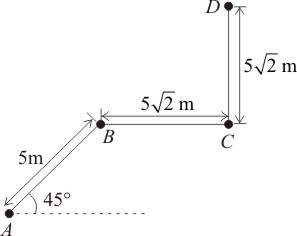This video is available for NEETprep Video Course students only
You’ve reached the end of your free Videos limit.
#6-Solved-Examples-3
(Physics) > Motion in A Straight Line
My Notes
Create your notes while watching video by clicking on icon in video player.
Related Practice Questions :
The displacement \(x\) of a particle moving in one dimension under the action of a constant force is related to time \(t\) by the equation \(t=\sqrt{x}+3,\) where \(x\) is in meters and \(t\) is in seconds. What is the displacement of the particle from \(t=0~\text s\) to \(t = 6~\text s?\)
1. \(0\)
2. \(12~\text m\)
3. \(6~\text m\)
4. \(18~\text m\)
58%
From NCERT
To view explanation, please take trial in the course.
NEET 2025 - Target Batch
Hints
Links
To view explanation, please take trial in the course.
NEET 2025 - Target Batch
Given below are two statements:
| Assertion (A): | Position-time graph of a stationary object is a straight line parallel to the time axis. |
| Reason (R): | For a stationary object, the position does not change with time. |
| 1. | Both (A) and (R) are True and (R) is the correct explanation of (A). |
| 2. | Both (A) and (R) are True but (R) is not the correct explanation of (A). |
| 3. | (A) is True but (R) is False. |
| 4. | Both (A) and (R) are False. |
88%
From NCERT
To view explanation, please take trial in the course.
NEET 2025 - Target Batch
Hints
Links
To view explanation, please take trial in the course.
NEET 2025 - Target Batch
Given below are two statements:
| Assertion (A): | Displacement of a body may be zero when distance travelled by it is not zero. |
| Reason (R): | The displacement is the longest distance between initial and final position. |
| 1. | Both (A) and (R) are True and (R) is the correct explanation of (A). |
| 2. | Both (A) and (R) are True but (R) is not the correct explanation of (A). |
| 3. | (A) is True but (R) is False. |
| 4. | Both (A) and (R) are False. |
81%
From NCERT
To view explanation, please take trial in the course.
NEET 2025 - Target Batch
Hints
To view explanation, please take trial in the course.
NEET 2025 - Target Batch
If the velocity of a particle is , where A and B are constants, then the distance travelled by it between 1s and 2s is?
83%
From NCERT
NEET - 2016
To view explanation, please take trial in the course.
NEET 2025 - Target Batch
Hints
Links
To view explanation, please take trial in the course.
NEET 2025 - Target Batch
A particle moves along a path \(ABCD\) as shown in the figure. The magnitude of the displacement of the particle from \(A\) to \(D\) is:

1. m
2. \(10\) m
3. m
4. \(15\) m
71%
From NCERT
To view explanation, please take trial in the course.
NEET 2025 - Target Batch
Hints
To view explanation, please take trial in the course.
NEET 2025 - Target Batch
